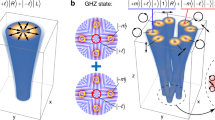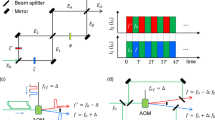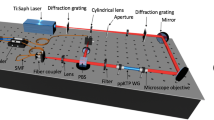Abstract
Advanced quantum technologies require scalable and controllable quantum resources1,2. Gaussian states of multimode light, such as squeezed states and cluster states, are scalable quantum systems3,4,5, which can be generated on demand. However, non-Gaussian features are indispensable in many quantum protocols, especially to reach a quantum computational advantage6. Embodying non-Gaussianity in a multimode quantum state remains a challenge as non-Gaussian operations generally cannot maintain coherence among multiple modes. Here, we generate non-Gaussian quantum states of a multimode light field by removing a single photon in a mode-selective manner from a Gaussian state7. To highlight the potential for continuous-variable quantum technologies, we first demonstrated the capability to generate negativity of the Wigner function in a controlled mode. Subsequently, we explored the interplay between non-Gaussianity and quantum entanglement and verify a theoretical prediction8 about the propagation of non-Gaussianity along the nodes of photon-subtracted cluster states. Our results demonstrate large-scale non-Gaussianity with great flexibility along with an ensured compatibility with quantum information protocols. This range of features makes our approach ideal to explore the physics of non-Gaussian entanglement9,10 and to develop quantum protocols, which range across quantum computing11,12, entanglement distillation13 and quantum simulations14.
This is a preview of subscription content, access via your institution
Access options
Access Nature and 54 other Nature Portfolio journals
Get Nature+, our best-value online-access subscription
$29.99 / 30 days
cancel any time
Subscribe to this journal
Receive 12 print issues and online access
$209.00 per year
only $17.42 per issue
Buy this article
- Purchase on Springer Link
- Instant access to full article PDF
Prices may be subject to local taxes which are calculated during checkout



Similar content being viewed by others
Data availability
The data that support the plots within this paper and other findings of this study are available from the corresponding author upon reasonable request.
References
Andersen, U. L., Neergaard-Nielsen, J. S., van Loock, P. & Furusawa, A. Hybrid discrete- and continuous-variable quantum information. Nat. Phys. 11, 713–719 (2015).
Biamonte, J. et al. Quantum machine learning. Nature 549, 195–202 (2017).
Yokoyama, S. et al. Ultra-large-scale continuous-variable cluster states multiplexed in the time domain. Nat. Photonics 7, 982–986 (2013).
Roslund, J., Medeiros de Araújo, R., Jiang, S., Fabre, C. & Treps, N. Wavelength-multiplexed quantum networks with ultrafast frequency combs. Nat. Photonics 8, 109–112 (2014).
Chen, M., Menicucci, N. C. & Pfister, O. Experimental realization of multipartite entanglement of 60 modes of a quantum optical frequency comb. Phys. Rev. Lett. 112, 120505 (2014).
Mari, A. & Eisert, J. Positive Wigner functions render classical simulation of quantum computation efficient. Phys. Rev. Lett. 109, 230503 (2012).
Averchenko, V., Jacquard, C., Thiel, V., Fabre, C. & Treps, N. Multimode theory of single-photon subtraction. New J. Phys. 18, 083042 (2016).
Walschaers, M., Sarkar, S., Parigi, V. & Treps, N. Tailoring non-Gaussian continuous-variable graph states. Phys. Rev. Lett. 121, 220501 (2018).
Valido, A. A., Levi, F. & Mintert, F. Hierarchies of multipartite entanglement for continuous-variable states. Phys. Rev. A 90, 052321 (2014).
Park, K., Marek, P. & Filip, R. Conditional superpositions of Gaussian operations on different modes of light. Phys. Rev. A 91, 033814 (2015).
Lloyd, S. & Braunstein, S. L. Quantum computation over continuous variables. Phys. Rev. Lett. 82, 1784–1787 (1999).
Menicucci, N. C. et al. Universal quantum computation with continuous-variable cluster states. Phys. Rev. Lett. 97, 110501 (2006).
Eisert, J., Scheel, S. & Plenio, M. B. Distilling Gaussian states with Gaussian operations is impossible. Phys. Rev. Lett. 89, 137903 (2002).
Banchi, L., Fingerhuth, M., Babej, T., Ing, C. and Arrazola, J.M. Molecular docking with Gaussian boson sampling. Preprint at https://arxiv.org/abs/1902.00462 (2019).
Aasi, J. et al. Enhanced sensitivity of the LIGO gravitational wave detector by using squeezed states of light. Nat. Photonics 7, 613–619 (2013).
Takeda, S., Mizuta, T., Fuwa, M., Van Loock, P. & Furusawa, A. Deterministic quantum teleportation of photonic quantum bits by a hybrid technique. Nature 500, 315–318 (2013).
Spekkens, R. W. Negativity and contextuality are equivalent notions of nonclassicality. Phys. Rev. Lett. 101, 020401 (2008).
Wenger, J., Tualle-Brouri, R. & Grangier, P. Non-Gaussian statistics from individual pulses of squeezed light. Phys. Rev. Lett. 92, 153601 (2004).
Ourjoumtsev, A., Tualle-Brouri, R., Laurat, J. & Grangier, P. Generating optical Schrödinger kittens for quantum information processing. Science 312, 83–86 (2006).
Ourjoumtsev, A., Ferreyrol, F., Tualle-Brouri, R. & Grangier, P. Preparation of non-local superpositions of quasi-classical light states. Nat. Phys. 5, 189–192 (2009).
Sychev, D. V. et al. Enlargement of optical Schrödinger’s cat states. Nat. Photonics 11, 379–382 (2017).
Serikawa, T. et al. Generation of a cat state in an optical sideband. Phys. Rev. Lett. 121, 143602 (2018).
Biagi, N., Costanzo, L. S., Bellini, M. and Zavatta, A. Entangling macroscopic light states by delocalized photon addition. Preprint at https://arxiv.org/abs/1811.10466 (2018).
Jeong, H. et al. Generation of hybrid entanglement of light. Nat. Photonics 8, 564–569 (2014).
Morin, O. et al. Remote creation of hybrid entanglement between particle-like and wave-like optical qubits. Nat. Photonics 8, 570–574 (2014).
Das, T., Prabhu, R., Sen De, A. & Sen, U. Superiority of photon subtraction to addition for entanglement in a multimode squeezed vacuum. Phys. Rev. A 93, 052313 (2016).
Walschaers, M., Fabre, C., Parigi, V. & Treps, N. Entanglement and Wigner function negativity of multimode non-Gaussian states. Phys. Rev. Lett. 119, 183601 (2017).
Ansari, V., Donohue, J. M., Brecht, B. & Silberhorn, C. Tailoring nonlinear processes for quantum optics with pulsed temporal-mode encodings. Optica 5, 534–550 (2018).
Cai, Y. et al. Multimode entanglement in reconfigurable graph states using optical frequency combs. Nat. Commun. 8, 15645 (2017).
Ra, Y.-S., Jacquard, C., Dufour, A., Fabre, C. & Treps, N. Tomography of a mode-tunable coherent single-photon subtractor. Phys. Rev. X 7, 031012 (2017).
Bogdanov, Y. I. et al. Multiphoton subtracted thermal states: description, preparation, and reconstruction. Phys. Rev. A 96, 063803 (2017).
Marek, P., Provazník, J. & Filip, R. Loop-based subtraction of a single photon from a traveling beam of light. Opt. Express 26, 29837–29847 (2018).
Katamadze, K. G., Avosopiants, G. V., Bogdanov, Y. I. & Kulik, S. P. How quantum is the ‘quantum vampire’ effect?: testing with thermal light. Optica 5, 723–726 (2018).
Ježek, M. et al. Experimental test of the strongly nonclassical character of a noisy squeezed single-photon state. Phys. Rev. A 86, 043813 (2012).
Albarelli, F., Genoni, M. G., Paris, M. G. A. & Ferraro, A. Resource theory of quantum non-Gaussianity and Wigner negativity. Phys. Rev. A 98, 052350 (2018).
Plick, W. N., Arzani, F., Treps, N., Diamanti, E. & Markham, D. Violating bell inequalities with entangled optical frequency combs and multipixel homodyne detection. Phys. Rev. A 98, 062101 (2018).
Neergaard-Nielsen, J., Nielsen, B., Hettich, C., Molmer, K. & Polzik, E. Generation of a superposition of odd photon number states for quantum information networks. Phys. Rev. Lett. 97, 083604 (2006).
Duan, L.-M., Giedke, G., Cirac, J. I. & Zoller, P. Inseparability criterion for continuous variable systems. Phys. Rev. Lett. 84, 2722–2725 (2000).
Simon, R. Peres–Horodecki separability criterion for continuous variable systems. Phys. Rev. Lett. 84, 2726–2729 (2000).
Bowen, W. P., Schnabel, R., Lam, P. K. & Ralph, T. C. Experimental investigation of criteria for continuous variable entanglement. Phys. Rev. Lett. 90, 043601 (2003).
van Loock, P., Weedbrook, C. & Gu, M. Building Gaussian cluster states by linear optics. Phys. Rev. A 76, 032321 (2007).
Acknowledgments
We thank Valentina Parigi for fruitful discussions. This work is supported by the French National Research Agency project COMB and the European Union Grant QCUMbER (no. 665148). N.T. is a member of the Institut Universitaire de France. Y.-S.R. acknowledges support from the European Commission through Marie Skłodowska-Curie actions (no. 708201) and the National Research Foundation of Korea funded by the Ministry of Education (NRF-2018R1A6A3A03012129) and the Ministry of Science and ICT (NRF-2019R1C1C1005196). M.W. acknowledges funding through research fellowship WA 3969/2-1 from the German Research Foundation.
Author information
Authors and Affiliations
Contributions
Y.-S.R. and A.D. conducted the experiments with help from C.J. and T.M. Y.-S.R. and M.W. analysed the data. M.W. developed the theoretical model. Y.-S.R., M.W. and N.T. wrote the manuscript with input from all the authors. C.F. and N.T. supervised the project. All the authors contributed to scientific discussions.
Corresponding author
Ethics declarations
Competing interests
The authors declare no competing interests.
Additional information
Peer Review Information Nature Physics thanks Marco Bellini and the other, anonymous, reviewer(s) for their contribution to the peer review of this work.
Publisher’s note Springer Nature remains neutral with regard to jurisdictional claims in published maps and institutional affiliations.
Extended data
Extended Data Fig. 1 Wigner function reconstructed with optical loss correction.
Optical loss only by the homodyne detection (\(12.5 \%\)) has been corrected. Comparing with Fig. 2, non-Gaussian Wigner functions show reduced \({W}_{0}\). Errors noted in parentheses are one standard deviations calculated by bootstrapping.
Extended Data Fig. 2 Purities of the Wigner functions in Fig. 2(a).
For comparison, the purity of a Wigner function by the ideal photon subtraction is provided in square brackets, which agrees well with the experimental result. Low purity in a photon-subtracted mode is attributed to a non-ideal input state19. No optical loss is corrected in the calculation. Errors noted in parentheses are one standard deviations calculated by bootstrapping.
Extended Data Fig. 3 Effect of mode mismatch between photon subtraction and measurement.
When a single photon is subtracted in \({{\rm{HG}}}_{0}-i{{\rm{HG}}}_{1}\), a Wigner function (without optical loss correction) is obtained in a measurement mode having (a) full match (\({{\rm{HG}}}_{0}-i{{\rm{HG}}}_{1}\)), (b) partial match (\(i{{\rm{HG}}}_{1}\)), and (c) no match (\({{\rm{HG}}}_{0}+i{{\rm{HG}}}_{1}\)). Errors noted in parentheses are one standard deviations calculated by bootstrapping.
Extended Data Fig. 4 Experimental covariance matrix.
(a) is for \(x\) quadratures, seen from above, and (b) is for \(p\) quadratures, seen from below. Mode indexes are \({{\rm{HG}}}_{0}\), \(i{{\rm{HG}}}_{1}\), \({{\rm{HG}}}_{2}\), and \(i{{\rm{HG}}}_{3}\), where \(i\) is added for the odd-index HG modes to have \(p\)-squeezed vacua in all modes. For clarity, the vacuum noise (corresponding to the identity matrix) is subtracted from the covariance matrix. In the covariance matrix, variances of (\(x\), \(p\)) quadratures are (\(2.8{\rm{dB}}\), \(-1.8{\rm{dB}}\)) in mode 0, (\(2.1{\rm{dB}}\), \(-1.6{\rm{dB}}\)) in mode 1, (\(1.6{\rm{dB}}\), \(-1.0{\rm{dB}}\)) in mode 2, and (\(1.4{\rm{dB}}\), \(-0.7{\rm{dB}}\)) in mode 3.
Source data
Source Data Fig. 2
Data of W\({}_{0}\) and F shown in Fig. 2.
Source Data Fig. 3
Data used to plot Fig. 3.
Source Data Extended Data Fig. 1
Data of W\({}_{0}\) and F shown in Extended Data Fig. 1.
Source Data Extended Data Fig. 3
Data of W\({}_{0}\) shown in Extended Data Fig. 3.
Rights and permissions
About this article
Cite this article
Ra, YS., Dufour, A., Walschaers, M. et al. Non-Gaussian quantum states of a multimode light field. Nat. Phys. 16, 144–147 (2020). https://doi.org/10.1038/s41567-019-0726-y
Received:
Accepted:
Published:
Issue Date:
DOI: https://doi.org/10.1038/s41567-019-0726-y
This article is cited by
-
Resolution of 100 photons and quantum generation of unbiased random numbers
Nature Photonics (2023)
-
Entanglement, Nonlocality, Quantum Teleportation of Two-mode Non-Gaussian States with Multiphoton Quantum Catalysis
International Journal of Theoretical Physics (2023)
-
Single-mode quantum non-Gaussian light from warm atoms
npj Quantum Information (2022)
-
Quantum optics of soliton microcombs
Nature Photonics (2022)
-
Distribution and quantification of remotely generated Wigner negativity
npj Quantum Information (2022)



